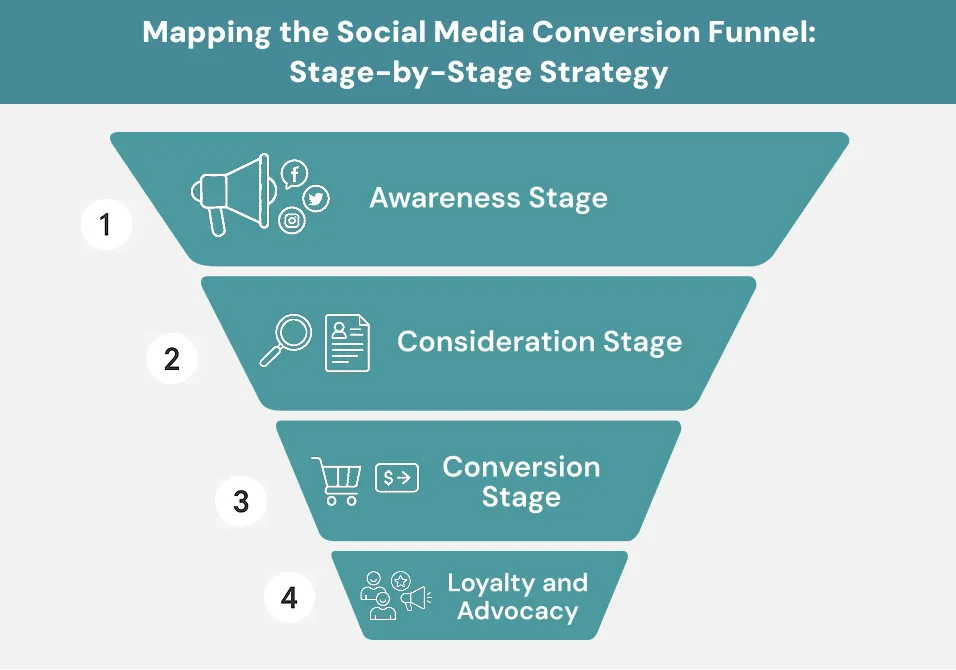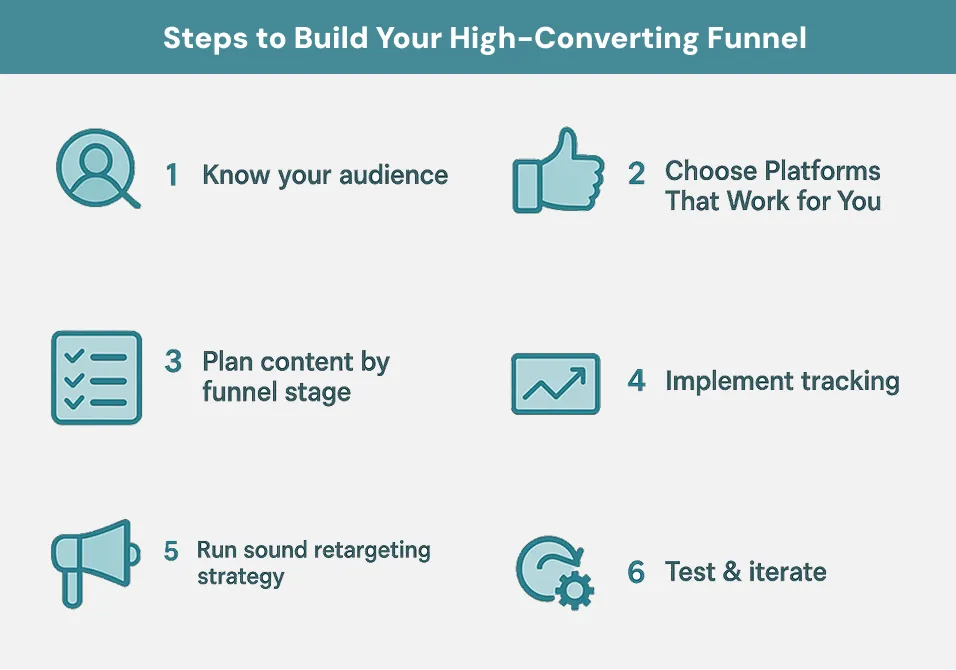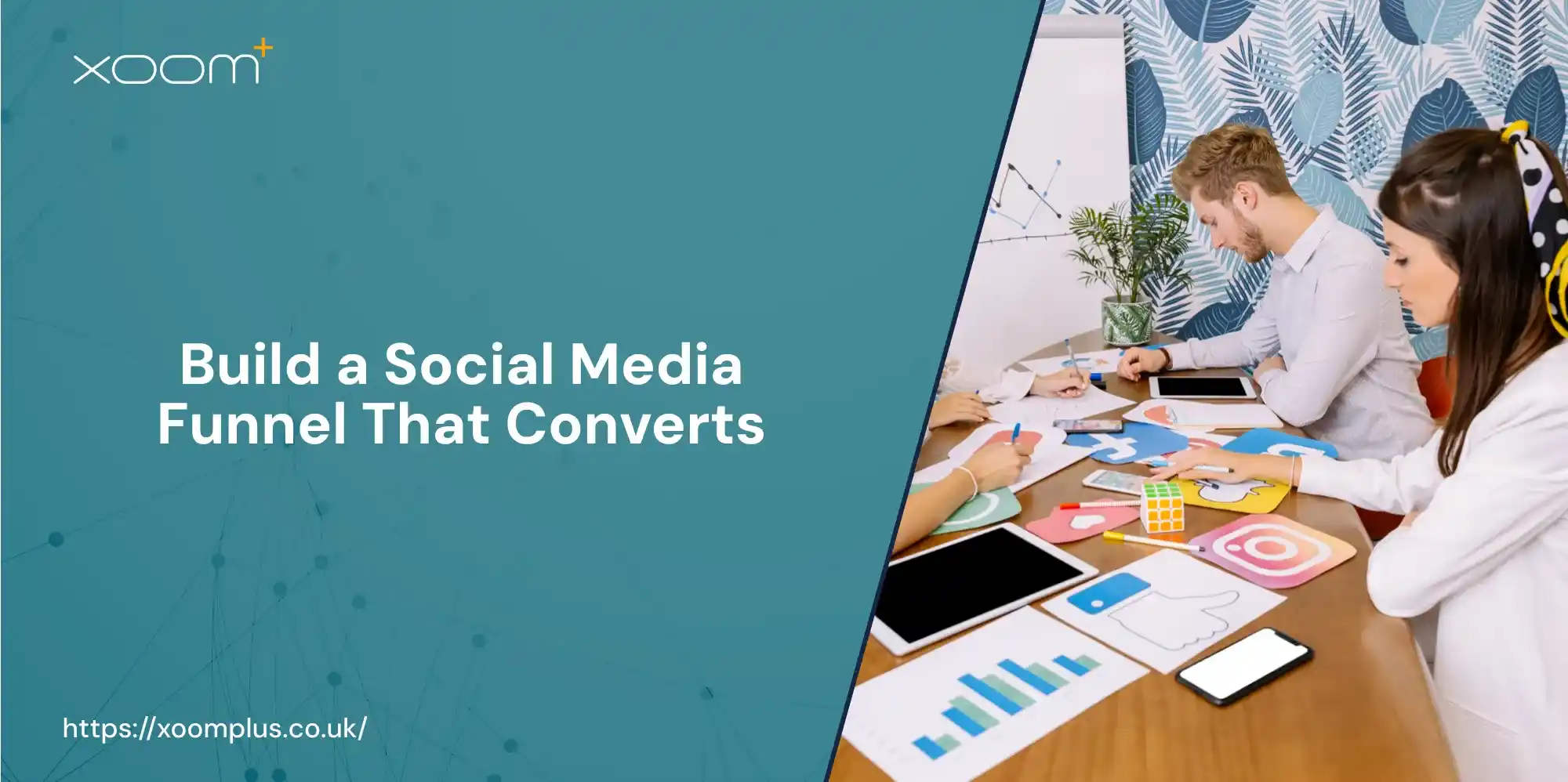- October 1, 2025
- Categories: Digital Marketing
How to Build a High-Converting Social Media Funnel in 2025?
Social media is now a full-scale commerce engine that accounts for 17.11% of the total sales, as reported
by a few studies. However, conversions are difficult to purchase, whereas exposure is. More than just viral
content is required by marketers to transform audiences from passive scrollers into devoted consumers. They
require a methodical approach that transforms focus into action. That is where a social media funnel comes in.
It is a structured journey guiding the potential customers from initial awareness all the way to long-term
advocacy. This blog covers everything you need to know about a high-converting social media funnel in
2025.
What Is a Social Media Funnel?
A social media funnel guides people in a structured way. It covers all the stages from discovering your brand to becoming your loyal customer. At each of these steps, the social media funnel uses unique messaging and content that resonates with the audience as they move forward in their journey. The end goal is that your audience doesn’t just turn into your followers. They should turn into your greatest advocates who recommend your brand to others as well.Non-Linear Journey of Social Media Funnel: Awareness to Advocacy
A social media funnel is not always a straight line, unlike other marketing funnels. People don’t follow all the steps. Sometimes they may jump between the stages. Other times, they may revisit your pages or pause before taking an action. It is therefore often known as a non-linear funnel. There are five main stages in a social media funnel. They are as follows:- Awareness: This is when someone discovers your brand or content
- Consideration: This is when the audience begins considering your brand and learning more about it
- Conversion: This is the stage where they take action. They sign up, buy, or book your product or service accordingly.
- Loyalty: They keep coming back to your business after their first purchase.
- Advocacy: Your audience feels satisfied enough to recommend your brand to their peers.
How It Connects to Marketing Models
A social media funnel is usually based on popular marketing models. For instance, it often follows AIDA (Attention, Interest, Desire, Action) or full-funnel marketing. Here are a few other examples of this:- The flywheel social media marketing funnel:
- The bow-tie social media marketing funnel:
Why Build a High-Converting Funnel in 2025?
Just social media activity is not enough now to keep your audience engaged. Users are already overwhelmed with content. To top it off, their attention spans are also short. With a high-converting social media funnel, your company can follow a defined route with a high-converting social media funnel. It ensures every post, article, advertisement, and video serves a precise purpose. People go from just seeing your content to actually buying from you. They also keep coming back. Here are key reasons that should convince you need for a social media marketing funnel in 2025.Social Media Is Now a Major Sales Channel
Social media was previously used for awareness. Now, it is different. People are actually shopping from social media now. As stated earlier, 17% of the total online sales this year have been from social media platforms. This number is expected to cross $1 trillion globally by 2028. This is because of Instagram checkouts and TikTok shops helping buyers make quick decisions without even leaving the apps. A social media funnel helps you capitalise on the right moments.. Your brand must show up at the right time with the right message.Influencers Directly Impact Purchases
Influencer marketing is part of the social media funnel. It is no longer just a trend. Studies suggest that around 49% people make at least one purchase a month based on the suggestion of influencers. Their reviews and unboxing lie at the middle of your social media marketing funnel. Sometimes they even give a product demo at this part. These actions build trust for your audience and motivate them to make a purchase as well. If you ignore the role of influencers, you’ll be missing out on social proof that already has your audience’s trust.Conversion Rates: Know Where You Stand
Creating a social media marketing funnel also makes it easier to monitor and enhance conversions. The average conversion rate for the funnel is estimated to be around 3.68%. Higher performing brands have it at 5.31% or higher. You have to measure each step of your social media funnel for conversions. You have to evaluate clicks, sign-ups, and purchases. Otherwise, you are flying blind. You can also determine what is working and what needs to be fixed by using benchmarks provided by high-performing social media marketing funnels.Small Funnel Changes = Big Revenue Gains
You can unlock major growth by making the slightest improvements in your social media funnel. For instance, diversifying your social media efforts across platforms may increase your e-commerce income by an additional 2 to 5%, according to research. This means that you should use both Instagram and Pinterest or TikTok and YouTube. Keeping the full social media marketing funnel in view while planning content not only gives you followers, but it also grows your sales.Mapping the Social Media Conversion Funnel: Stage-by-Stage Strategy
The creation of an effective social media funnel strategy is dependent on several factors. You have to know what to post and when to post it. Each phase of the funnel serves a specific purpose, and you should know what results you want from these stages. Casual scrollers become paying clients when the appropriate material is used at the appropriate moment. Here are the stages of the social media funnel:-
Awareness Stage (TOFU – Top of Funnel)

Video posts will get you the most traction on Facebook, while Instagram Stories will highlight your business the best at this stage. Similarly, you should use high-capturing visuals for Pinterest and LinkedIn. Now, what content would you show on these platforms? The easy answer to this is the content that the audience can digest most easily. Think of short videos, infographics, and relatable memes. Another thing that would work great on this stage is partnerships with microinfluencers. They have the trust of the audience even more than big celebrities.
What is the aim of this stage?
This stage is aimed at enhancing the visibility and reach of your brand. When you put effort into this stage, it translates well into conversions. If you don’t, it won’t translate well further down the social media marketing funnel. It is also important that you choose the right platform for this stage of the social media funnel. For instance, Facebook has an add to cart rate of 34% while TikTok’s is much lower, yet TikTok is excellent at creating awareness.-
Consideration Stage (MOFU – Middle of Funnel)
- How-to videos and tutorials that show your product in use
- Webinars or live sessions with Q&A
- Case studies
- Customer success stories
- Polls and quizzes
- FAQs to create two-way engagement
- Carousel posts that break down features or benefits in a visual way
How to Measure Success at the Consideration Stage
The success in this stage of your social media marketing funnel is based on how well you are able to engage your audience. Success signs point out that your audience is paying attention. To measure the success of your strategy, check the following:- Higher click-through rates (CTR)
- Longer content dwell time (people stick around and watch)
- More comments, shares, or reactions
- Increased email opt-ins or sign-ups for free resources
Tools and Techniques
For this stage of the social media marketing funnel, use retargeting ads to bring back people who engaged but did not convert. You can track where they came from through UTM parameters. Also, test different types of your content, post time, captions, thumbnails, etc., to check what performs better.-
Conversion Stage (BOFU – Bottom of Funnel)
- Demo videos
- Customer testimonials
- User-generated content
- Real-life reviews
The Role of Urgency
This is also the right moment to introduce urgency. You have to nudge people towards the decision. For this, use flash sales, special discounts, and countdown timers. But you must not be too pushy. The audience is always smart enough to tell the difference between a marketing gimmick and genuine urgency.How to measure success
In this stage of the social media marketing funnel, use the following metrics to track success:- Conversion rate
- Cost per acquisition (CPA)
- Cart abandonment rate
- Return on ad spend (ROAS)
-
Loyalty and Advocacy Stage (Post-Purchase Funnel)
How to measure success
To measure success at this stage of the social media marketing funnel, you can check the following:- Repeat purchase rate
- Customer lifetime value (CLV)
- Referral counts
- User-generated content submissions.
6 Steps to Build Your High-Converting Funnel
Here are the seven steps that can help you build a high-converting social media funnel:-
Know your audience
-
Choose Platforms That Work for You

-
Plan content by funnel stage
-
Implement tracking
-
Run sound retargeting strategy
-
Test & iterate
Conclusion
A high-converting social media funnel is not just based on great content. It is driven by data-based decisions, smart automation, and continuously optimising your strategy. Xoomplus can help you construct your funnel. We help you map each funnel stage so you can track your performance with precision. We simplify content planning and audience targeting for you. Our goal is to deliver the right message to the right audience at the right time. We take your funnel strategy from guesswork to a structured growth engine. To get help, contact us now.Ready to Turn Scrolls into Sales?
Xoomplus helps you build a high-converting social media funnel with smarter tracking, better targeting, and real-time optimisation, so every post moves your audience closer to action. Start scaling with purpose today.
Faqs
A social media funnel is a structured path that guides users from discovering your brand to becoming loyal customers using social media platforms. It includes stages like awareness, engagement, conversion, and post-purchase loyalty.
While both funnels follow similar stages, the social media funnel focuses on platform-specific content and real-time engagement. It leverages likes, shares, DMs, and influencer activity to drive action directly within apps.
The average conversion rate across social media funnels is around 2.35%. However, top-performing funnels can achieve 5.31% or more with the right targeting and content strategy.
Using multiple platforms like Instagram, TikTok, Pinterest, and Reddit together can boost ecommerce results by 2–5%. A cross-platform approach increases your chances of capturing users at different funnel stages.
Track key metrics for each stage, like reach, clicks, conversions, and repeat purchases—using tools such as GA4, Meta Pixel, and Supermetrics. Regularly reviewing this data helps you improve weak points and scale what works.

